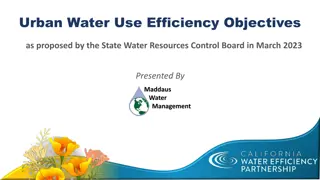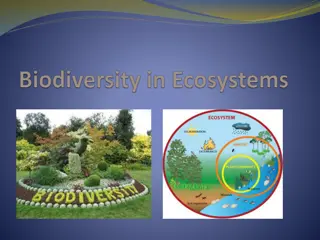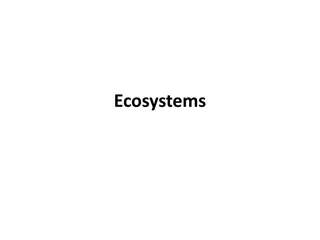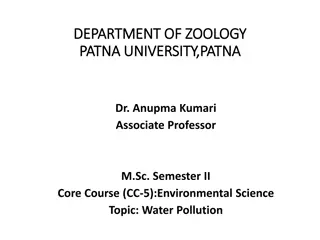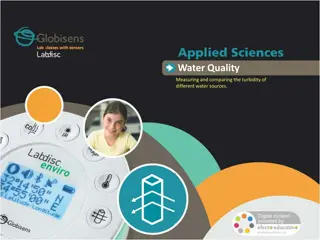Understanding Ecosystems: Types, Components, and Interactions
Different types of ecosystems, their components, and how they interact with each other. Explore natural ecosystems, such as deserts and rainforests, as well as artificial ecosystems. Discover the importance of terrestrial, aquatic, forest, marine, freshwater, tundra, and grassland ecosystems.
4 views • 6 slides
Alkaline Water Ionizer Machine In India | Best Alkaline water Machine
\n \nAre you fed up with consuming bland tap water that fails to deliver the health benefits you crave? Ionia presents a solution to revolutionize your water-drinking experience with our alkaline water ionizer machine. Our cutting-edge device converts regular tap water into premium-quality, antioxid
4 views • 5 slides
Water Ionizer India | Best Water Ionizer Machine
Water Ionizer India\n\nAre you worried about the purity of your drinking water? Look no further than Ionia, the premier provider of water ionizers in India. Our state-of-the-art technology converts ordinary tap water into pristine, alkaline, and antioxidant-rich water, ensuring optimal health and vi
2 views • 5 slides
Understanding Water Management: Principles, Practices, and Soil-Water Relations
Explore the principles and practices of water management in agriculture with a focus on water availability, nutrient relationships, and losses. Discover the physical classification of water, available water defined between field capacity and wilting point, soil water potential, and the soil-plant-at
6 views • 17 slides
Understanding Water Footprints: Impact and Awareness
Water is essential for all life, but our water footprint measures the hidden amount of water used to produce goods and services. This includes green, blue, and grey water footprints, as well as direct vs. indirect water consumption. Products like beef, cotton, and chocolate have high virtual water f
3 views • 13 slides
Water Filtration & Bottles Stay Refreshed Anywhere, Water Filtration & Bottles
Stay Refreshed Anywhere, Water Filtration & Bottles\nSurvival Supplies Australia understands the importance of staying hydrated outdoors. When you're on the move, having a clean and fresh supply of drinking water is essential. Our range, including water filter bottles and portable water filters, ens
3 views • 1 slides
State Water Resources Control Board's Urban Water Use Efficiency Objectives
The State Water Resources Control Board proposed Urban Water Use Efficiency Objectives in March 2023 to address the challenges of a hotter, drier future. The objectives include creating storage space for up to 4 million acre-feet of water, recycling and reusing at least 800,000 acre-feet of water pe
0 views • 32 slides
Understanding the Impact of Lead Contamination on Human Health and Ecosystems
Exploring the detrimental effects of lead exposure on human health and the environment, this content touches on lead contamination in drinking water, its effects on various bodily systems, and its impact on ecosystems. It also delves into the history of lead usage, major contributors to lead polluti
0 views • 18 slides
Why Regular Water Heater Maintenance in Boston is Crucial
Ever been jolted awake by a cold shower on a brisk Boston morning? That\u2019s a situation we all want to avoid! Regular water heater maintenance in Boston is key to ensuring your home stays cozy and your water heater functions efficiently. Let\u2019s explore why regular maintenance is crucial for y
1 views • 3 slides
Exploring the Major Types of Ecosystems
Explore the diverse world of ecosystems, including grassland, aquatic, forest, and desert ecosystems. Learn about the biotic and abiotic factors that shape these environments and the critical roles they play in supporting life. Delve into forest ecosystems with their canopy, floor, and soil features
0 views • 29 slides
Exploring Ocean Water Chemistry: Salinity, Saltiest Body of Water, and Gases
Delve into the complexity of ocean water chemistry, including the significance of salinity levels, the saltiest body of water on Earth at Don Juan Pond in Antarctica, the composition of salts in ocean water, and the role of gases like oxygen and carbon dioxide. Discover how these factors shape the c
0 views • 11 slides
Importance of Biodiversity and Sustainability in Ecosystems
Biodiversity, the richness of life in genes, species, and ecosystems, plays a crucial role in sustaining the health of our planet and its inhabitants. It provides essential resources such as food, medicine, and economic benefits. Sustainability, the ability of ecosystems to maintain their structure
1 views • 6 slides
Understanding Thermal Pollution and Its Impact on Water Systems
Thermal pollution results from the discharge of heated water into natural water bodies, leading to a harmful increase in temperature. This degradation of water quality has severe implications for aquatic ecosystems, causing harm to fish, shellfish, and plants. Major sources include nuclear power pla
0 views • 10 slides
Understanding Ecosystems: Structure, Function, and Importance
Ecosystems are diverse and interconnected environments that consist of living and non-living components. This content explores the concept of ecosystems, their structure, functions, and the importance of understanding and preserving them. Topics covered include producers, consumers, decomposers, ene
0 views • 22 slides
Exploring Different Types of Ecosystems and Their Characteristics
Ecosystems are diverse environments encompassing both living organisms and non-living factors. From forest and grassland ecosystems to deserts and tundras, each type has unique features and interactions. Forests house a variety of organisms, while grasslands are dominated by grass and herbs. Deserts
0 views • 10 slides
Understanding Ecosystems: Structure, Components, and Functions
Ecosystems are intricate units where living organisms interact with each other and the environment. They consist of biotic (living) and abiotic (non-living) components, interrelated in a chain of interactions. Biotic components include autotrophs, heterotrophs, and decomposers, while abiotic compone
0 views • 15 slides
Understanding Ecology: Ecosystems, Biodiversity, and Energy Flow
Explore the intricate world of ecology through topics such as ecosystems, biodiversity, energy flow, and nutrient cycling. Delve into the concept of niches, biodiversity levels, and the importance of energy flow and materials cycling in sustaining ecosystems. Learn about the nitrogen and carbon cycl
1 views • 18 slides
Understanding Ecosystems and Global Biomes: A Comprehensive Study
Explore the fascinating world of ecosystems, producers, consumers, and the vital role of decomposers within these intricate systems. Delve into the impact of environmental changes like deforestation on ecosystems. Discover the geographical features and significance of hot deserts, tropical forests,
0 views • 26 slides
The Global Water Crisis and Transboundary Issues in Southern Africa
The global water crisis is a pressing issue affecting millions worldwide, with about 700 million people currently living below the water-stress threshold. By 2025, this number is projected to reach 3 billion. The increasing pressure on shared water resources in countries like Botswana, Namibia, and
0 views • 52 slides
Explore Diverse Ecosystems through Visuals
Dive into the world of ecosystems with stunning images showcasing biogeographical realms, regions, ecological succession, lichens, mosses, forest types like coniferous, evergreen, deciduous, and thorn forests, as well as mangroves. Discover grassland ecosystems, fauna, desert ecosystems, and various
0 views • 20 slides
Understanding Ecosystems: A Comprehensive Guide
An ecosystem comprises both living (biotic) and non-living (abiotic) factors interacting in a specific area, with populations, communities, and ecology playing essential roles. Abiotic factors like temperature, water, sunlight, and wind influence species distribution, while biomes categorize ecosyst
1 views • 23 slides
Understanding Ecosystems: Definition, Structure, and Function
Ecosystems consist of living and non-living parts forming stable systems. They involve energy flow, nutrient cycling, and interactions between organisms and their environment. Ecosystems vary in abiotic and biotic conditions, with producers, consumers, and decomposers playing key roles. Changes in t
0 views • 13 slides
Enhancing Local Economic Ecosystems for Sustainable Growth
Strategically defining and categorizing key players in local economic ecosystems can lead to more informed decision-making by public services, optimizing resource utilization, and maximizing community assets for impactful results. Ecosystem champions should possess a diverse skill set, including kno
0 views • 7 slides
Understanding Water Pollution and Its Impact on the Environment
Water pollution is a significant environmental issue caused by the contamination of water bodies with toxic substances like chemicals and microorganisms. This degradation in water quality poses risks to both humans and ecosystems. The pollutants stem from various sources such as agricultural runoff,
0 views • 59 slides
Examples of Food Chains and Webs in Different Ecosystems
In the provided content, food chains and webs are illustrated in various ecosystems including desert, lake, and jungle. Each ecosystem depicts the interdependent relationships between producers, primary consumers, secondary consumers, and tertiary consumers, showcasing the flow of energy throughout
0 views • 38 slides
Overview of GLAAS and TrackFin in Relation to SDGs & Monitoring Initiatives
GLAAS and TrackFin play crucial roles in aligning with SDGs, particularly focusing on water and sanitation targets. The 2030 Agenda emphasizes the importance of sustainable development through various global indicators and targets, such as access to basic services, universal health coverage, and mit
2 views • 22 slides
Water Storage Tanks Hydraulic Modeling and Water Quality Considerations
This presentation by Justine Carroll, P.E., Project Manager, focuses on the hydraulic modeling and water quality considerations related to water storage tanks. It covers topics such as water age evaluation, steady state modeling, extended period simulations, pump controls, demand patterns, EPS verif
0 views • 34 slides
Understanding Global Ecosystems and Climate Influences
Global ecosystems are defined by dominant vegetation types and are influenced by factors like climate, atmospheric circulation, altitude, relief, and ocean currents. The distribution and characteristics of ecosystems are shaped by global atmospheric circulation patterns, creating distinct belts of v
0 views • 18 slides
IIASA's Water Program: History, Strategy, and Progress
IIASA's Water Program focuses on addressing water insecurity, uncertain futures, food security, degraded water environments, and the impacts of floods and droughts. Their mission involves conducting interdisciplinary research to identify sustainable water solutions for improving human well-being thr
0 views • 10 slides
Improving Water Quality and Supply Efficiency for Yorkshire Water Customers
Yorkshire Water aims to enhance water quality and reduce interruptions in supply for its customers. By investing in maintenance and modernization of water mains, they seek to address issues related to the look, taste, and smell of tap water, as well as minimize unplanned interruptions to the water s
0 views • 30 slides
Understanding Ecosystems: The Interplay of Living and Nonliving Elements
Ecology is the study of relationships within ecosystems, where living organisms interact with each other and their environment. Ecosystems range in size from the vast Sahara Desert to small puddles, influenced by abiotic factors like water, temperature, sunlight, and more. Maintaining balance is cru
0 views • 13 slides
Understanding Water Potential in Plant Physiology
Water potential is a crucial concept in plant physiology, driving the movement of water within plants. It is a measure of potential energy in water and influences processes like photosynthesis. This potential is influenced by factors such as solute concentration, pressure, gravity, and matrix effect
0 views • 25 slides
Fascinating Facts About Water and Its Importance
Water is an essential resource, with only a small percentage being fresh and usable. The water cycle, water usage statistics, and the significance of water for people, plants, and animals are highlighted. The content covers details on global water distribution, water scarcity in Australia, and daily
1 views • 9 slides
Understanding Water Quality Variables and Their Impact on Ecosystems
Water quality variables play a crucial role in natural ecological systems and human water use. Factors like mineral concentrations, toxins, and disease organisms affect the suitability of water for various purposes such as drinking, livestock, irrigation, and industrial use. Density and temperature
0 views • 18 slides
Impact of Hoover Dam on Ecosystems and Hydroelectricity
The Hoover Dam, built in 1935 on the Colorado River during the Great Depression, plays a significant role in controlling floods, providing power to millions, and impacting ecosystems and water supplies. The dam's construction altered the natural flow of water, changed the local climate, and created
0 views • 9 slides
Understanding Earth's Water Resources
Earth's water budget reveals that only a small fraction is fresh water, with a significant portion stored in ice caps and glaciers. Groundwater plays a vital role, housed in aquifers, where recharge and water table levels are crucial. Springs and surface water sources like rivers and lakes are essen
0 views • 10 slides
Fascinating Facts About Water and Its Properties
Explore interesting facts about water, including its crucial role for life on Earth, the distribution of water on our planet, and the properties of the water molecule. Learn about the importance of water for human health, the chemical reactions that form water, and the different states of water. Dis
0 views • 26 slides
Water Infrastructure Financing in Utah: Overview of Revolving Loan Funds
Utah's water infrastructure financing system is managed through revolving loan funds established by the Board of Water Resources. These funds date back to 1947 and have been consistently funded from various sources to support projects related to water supply, flood control, and dam safety. The progr
0 views • 12 slides
Water Quality - Measuring Turbidity of Different Water Sources
The activity involves comparing the turbidity of various natural and artificial water sources using a Labidsc turbidity sensor. Monitoring water quality is crucial for identifying pollutants, trends, and usage patterns in water resources. Factors like human activities affecting water quality through
0 views • 18 slides
Exploring the Vital Role of Water in the Water Cycle and Ocean Currents
Water, the essence of life, plays a crucial role in our ecosystem through the water cycle. From evaporation to condensation, and precipitation, water moves between states, sustaining life and influencing weather patterns. Additionally, ocean currents drive the movement of water worldwide, impacting
0 views • 16 slides






